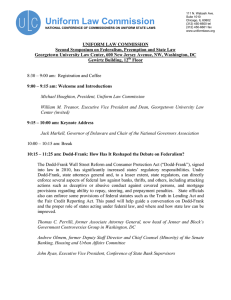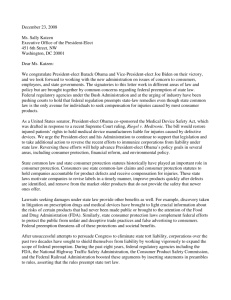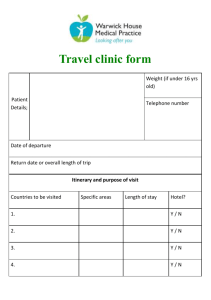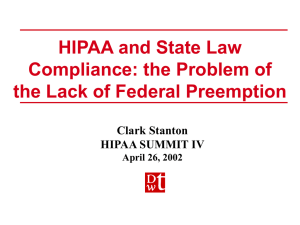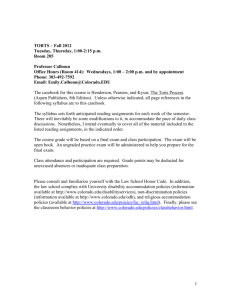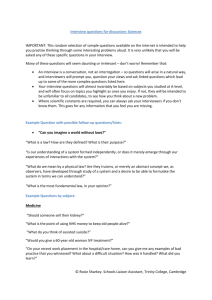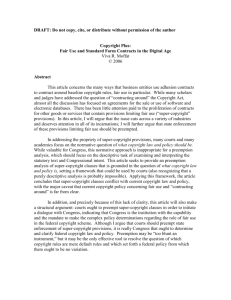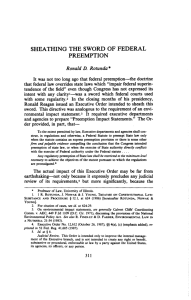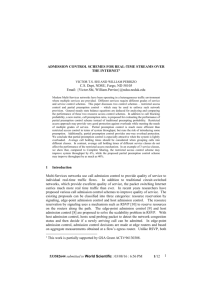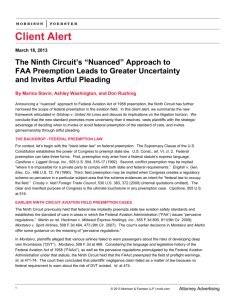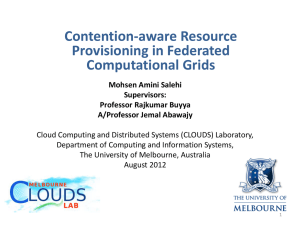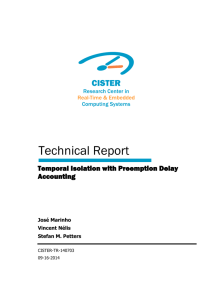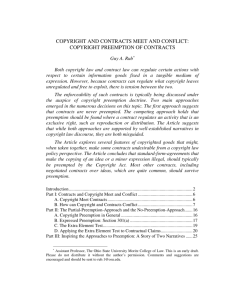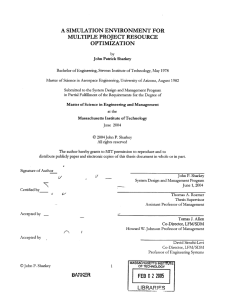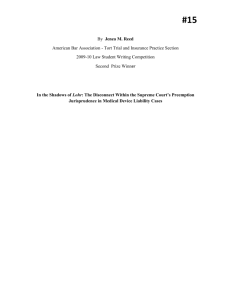“Private” tort law and “public” regulatory law often apply to the same
advertisement
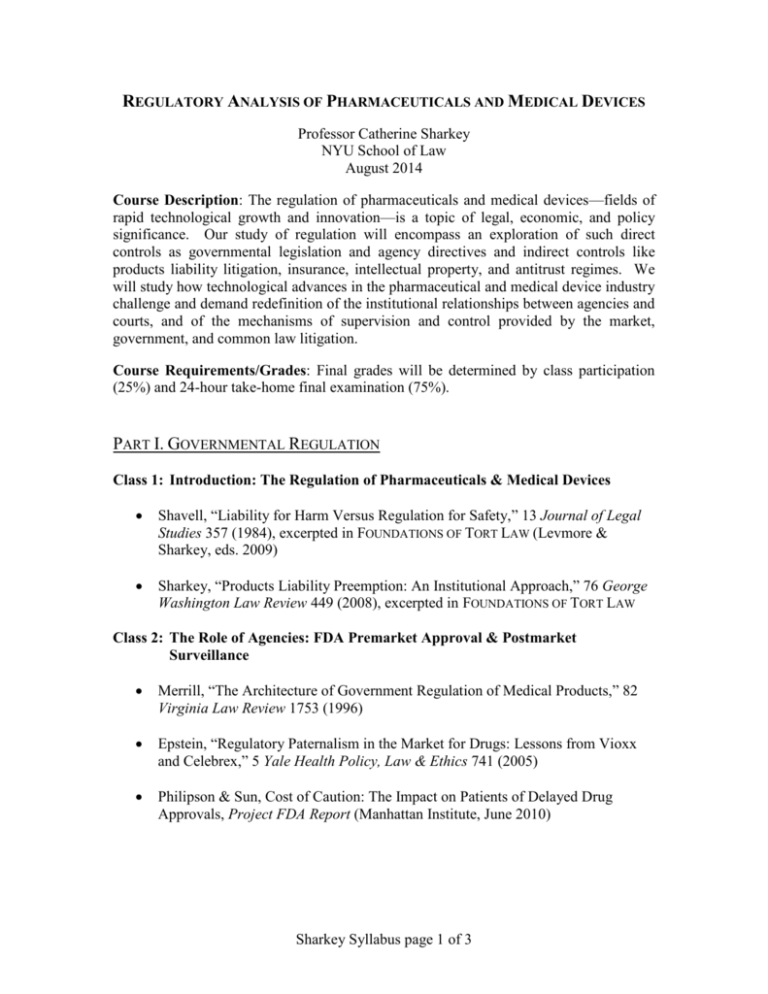
REGULATORY ANALYSIS OF PHARMACEUTICALS AND MEDICAL DEVICES Professor Catherine Sharkey NYU School of Law August 2014 Course Description: The regulation of pharmaceuticals and medical devices—fields of rapid technological growth and innovation—is a topic of legal, economic, and policy significance. Our study of regulation will encompass an exploration of such direct controls as governmental legislation and agency directives and indirect controls like products liability litigation, insurance, intellectual property, and antitrust regimes. We will study how technological advances in the pharmaceutical and medical device industry challenge and demand redefinition of the institutional relationships between agencies and courts, and of the mechanisms of supervision and control provided by the market, government, and common law litigation. Course Requirements/Grades: Final grades will be determined by class participation (25%) and 24-hour take-home final examination (75%). PART I. GOVERNMENTAL REGULATION Class 1: Introduction: The Regulation of Pharmaceuticals & Medical Devices • Shavell, “Liability for Harm Versus Regulation for Safety,” 13 Journal of Legal Studies 357 (1984), excerpted in FOUNDATIONS OF TORT LAW (Levmore & Sharkey, eds. 2009) • Sharkey, “Products Liability Preemption: An Institutional Approach,” 76 George Washington Law Review 449 (2008), excerpted in FOUNDATIONS OF TORT LAW Class 2: The Role of Agencies: FDA Premarket Approval & Postmarket Surveillance • Merrill, “The Architecture of Government Regulation of Medical Products,” 82 Virginia Law Review 1753 (1996) • Epstein, “Regulatory Paternalism in the Market for Drugs: Lessons from Vioxx and Celebrex,” 5 Yale Health Policy, Law & Ethics 741 (2005) • Philipson & Sun, Cost of Caution: The Impact on Patients of Delayed Drug Approvals, Project FDA Report (Manhattan Institute, June 2010) Sharkey Syllabus page 1 of 3 Class 3: The Dissemination of Information: Labeling & Advertising • Hayes, “Drug Labeling and Promotion: Evolution and Application of Regulatory Policy,” 51 Food & Drug Law Journal 57 (1996) • Woosley, “Drug Labeling Revisions—Guaranteed to Fail?” 284 Journal of American Medical Association 3047 (2000) • Gibbons et al., “Early Evidence on the Effects of Regulators’ Suicidality Warnings on SSRI Prescriptions and Suicide in Children and Adolescents,” 164 American Journal of Psychiatry 1356 (2007) • Sharkey, “Prescription Drug Advertising: Preemption’s New Frontier,” 41 Loyola L.A. Law Review 1625 (2008) • Sorrell v. IMS Health Inc., 131 S. Ct. 2653 (2011) PART II. PRODUCTS LIABILITY LITIGATION Class 4: Manufacturing Defects, Design Defects & Failure to Warn Claims • Conk, “Is There a Design Defect in the Restatement (Third) of Torts: Products Liability?” 109 Yale Law Journal 1087 (2000) • MacDonald v. Ortho Pharmaceutical Corp., 475 N.E.2d 65 (Mass. 1985) • Noah, “Adding Insult to Injury: Paying for Harms Caused by a Competitor’s Copycat Product,” Tort Trial & Insurance Practice Law Journal (2010) Class 5: FDA-Approved Drugs & Devices: Federal Preemption of Tort Claims • Riegel v. Medtronic, 552 U.S. 312 (2008) [medical device preemption] • Wyeth v. Levine, 555 U.S. 555 (2009) [brand-name drug preemption] • Mutual Pharm. Co. v. Bartlett, 570 U.S. __ (June 24, 2013) [generic preemption] Sharkey Syllabus page 2 of 3 Class 6: The Special Case of Vaccines • Sing & Willian,“Supplying Vaccines: An Overview of the Market and Regulatory Context,” in SUPPLYING VACCINES: AN ECONOMIC ANALYSIS OF CRITICAL ISSUES (Pauly et al. eds. 1996) • Arnould & DeBrock, “The Application of Economic Theory to the Vaccine Market,” in SUPPLYING VACCINES: AN ECONOMIC ANALYSIS OF CRITICAL ISSUES • Bruesewitz v. Wyeth LLC, 131 S. Ct. 1068 (2011) [vaccine preemption] • Sharkey, “Against Categorical Preemption: Vaccines and the Compensation Piece of the Preemption Puzzle,” 61 DePaul L. Rev. 1301 (2012) PART III: ECONOMICS & INNOVATION POLICY Class 7: Price, Insurance Coverage & Economics of Innovation • Noah, “Triage in the Nation’s Medicine Cabinet: The Puzzling Scarcity of Vaccines and Other Drugs,” 54 South Carolina Law Review 741 (2003) • Danzon & Pauly, “Health Insurance and the Growth in Pharmaceutical Expenditures,” 45 Journal of Law & Economics 587 (2002) • Lichtenberg, “Are the Benefits of Newer Drugs Worth Their Cost? Evidence From the 1996 MEPS,” Health Affairs, Sep/Oct 2001, at 241 Class 8: The Economics of Innovation: Market Exclusivity, Competition & Antitrust • Sykes, “TRIPs, Pharmaceuticals, Developing Countries and the Doha ‘Solution,’” 3 Chicago Journal of International Law 47 (2002) • Eisenberg, “The Role of the FDA in Innovation Policy,” 13 Michigan Telecommunications & Technology Law Review 345 (2007) • Hemphill, “Paying for Delay: Pharmaceutical Patent Settlement as a Regulatory Design Problem,” 81 New York University Law Review 1553 (2006) • Hemphill & Sampat, “Drug Patents at the Supreme Court,” 339 Science 1386 (March 2013) • Federal Trade Commission v. Actavis, Inc., 133 S. Ct. 2223 (June 17, 2013) Sharkey Syllabus page 3 of 3
